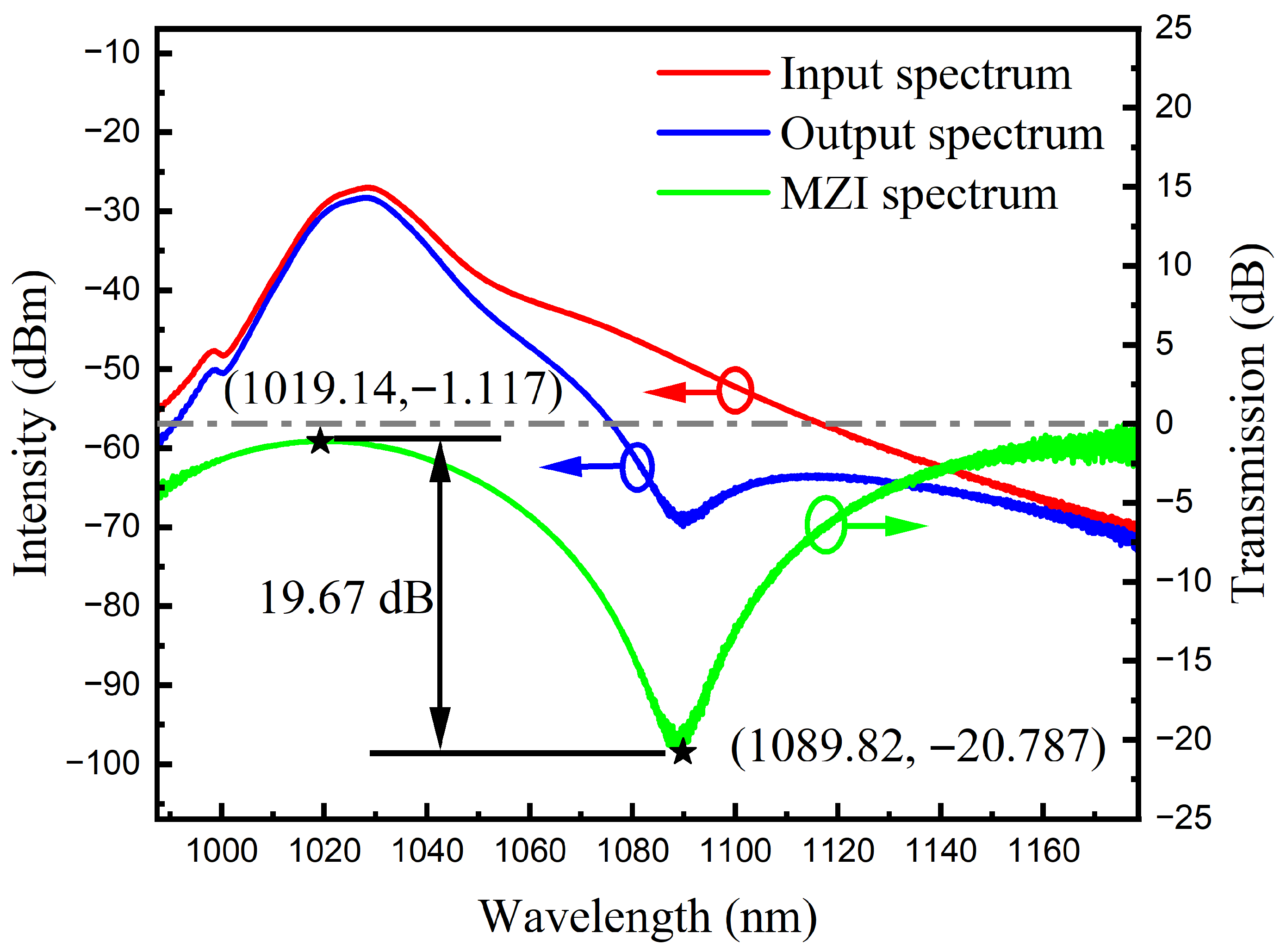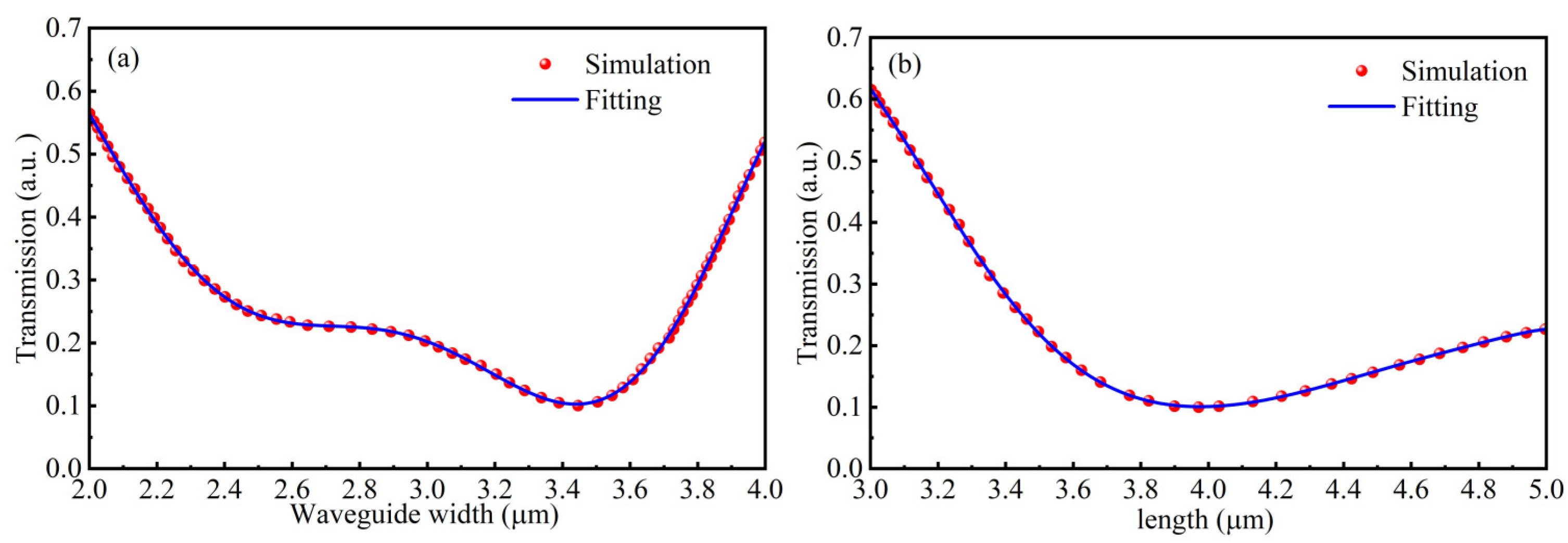Ultrafast Laser Writing of In-Line Filters Based on MZI
Abstract
1. Introduction
2. Method
3. Results and Discussion
3.1. Performance Comparison
3.2. Temperature Response
3.3. Waveguide Optimization
4. Conclusions
Author Contributions
Funding
Institutional Review Board Statement
Informed Consent Statement
Data Availability Statement
Acknowledgments
Conflicts of Interest
References
- Chong, A.; Buckley, J.; Renninger, W.; Wise, F. All-normal-dispersion femtosecond fiber laser. Opt. Express 2006, 14, 10095–10100. [Google Scholar] [CrossRef]
- Xu, Y.; Lu, P.; Qin, Z.; Harris, J.; Baset, F.; Lu, P.; Bhardwaj, V.R.; Bao, X. Vibration sensing using a tapered bend-insensitive fiber- based Mach-Zehnder interferometer. Opt. Express 2013, 21, 3031–3042. [Google Scholar] [CrossRef]
- Du, C.; Wang, Q.; Zhao, Y.; Hu, S. Ultrasensitive long-period gratings sensor works near dispersion turning point and mode transition region by optimally designing a photonic crystal fiber. Opt. Laser Technol. 2019, 112, 261–268. [Google Scholar] [CrossRef]
- Lee, S.; Jung, Y.; Choi, H.; Sohn, I.; Lee, J. Hybrid LPG-FBG based high-resolution micro bending strain sensor. Sensors 2021, 21, 22. [Google Scholar] [CrossRef]
- Fu, C.; Sui, R.; Peng, Z.; Meng, Y.; Zhong, H.; Shan, R.; Liang, W.; Liao, C.; Yin, X.; Wang, Y. Wide-range OFDR strain sensor based on the femtosecond-laser-inscribed weak fiber Bragg grating array. Opt. Lett. 2023, 48, 5819–5822. [Google Scholar] [CrossRef]
- Jing, L.; Liu, B.; Liu, D.; Liu, D.; Wang, F.; Guan, C.; Wang, Y.; Liao, C. Femtosecond laser inscribed excessively titled fiber grating for humidity sensing. Sensors 2024, 24, 342. [Google Scholar] [CrossRef]
- Dong, J.; Chiang, K.S. Transverse-mode switchable passively mode-locked fiber laser based on a two-mode fiber Bragg grating. In Proceedings of the 2014 OptoElectronics and Communication Conference and Australian Conference on Optical Fibre Technology, Melbourne, VIC, Australia, 6–10 July 2014; pp. 65–67. [Google Scholar]
- Wang, T.; Yan, Z.; Mou, C.; Liu, Z.; Liu, Y.; Zhou, K.; Zhang, L. Narrow bandwidth passively mode locked picosecond erbium doped fiber laser using a 45° tilted fiber grating device. Opt. Express 2017, 25, 16708–16714. [Google Scholar] [CrossRef] [PubMed]
- Guo, X.; Huang, X.; Li, X.; Luo, P.; Gao, C.; Wang, R.; Wang, Y.; Xi, F.; Yin, X.; Zhang, K. 1.9 ultra-narrow spectral width mode-locked pulsed laser based on femtosecond laser inscribed FBG. Opt. Lasers Eng. 2024, 181, 108441. [Google Scholar] [CrossRef]
- Dostovalov, A.V.; Wolf, A.A.; Babin, S.A. Long-period fiber grating writing with a slit-apertured femtosecond laser beam (). Quantum Electron. 2015, 45, 235–239. [Google Scholar] [CrossRef]
- Wang, J.; Shen, F.; Shu, X.; Zhou, K.; Jiang, H.; Xia, H.; Xie, K.; Zhang, L. Line by line inscribed small period long period grating for wide range refractive index sensing. Opt. Commun. 2022, 508, 127821. [Google Scholar] [CrossRef]
- Li, Q.; Cheng, P.; Zhao, R.; Cai, J.; Shen, M.; Shu, X. Mode-locked fiber laser based on a small-period long-period fiber grating inscribed by femtosecond laser. Opt. Lett. 2023, 48, 2241–2244. [Google Scholar] [CrossRef]
- Li, Y.; Tian, J.; Quan, M.; Yao, Y. Tunable Multiwavelength Er-doped fiber laser with a two stage lyot filter. IEEE Photonics Technol. Lett. 2017, 29, 287–290. [Google Scholar] [CrossRef]
- Xie, S.; Jin, L.; Zhang, H.; Li, X.; Zhang, X.; Xu, Y.; Ma, X. All-fiber high-power spatiotemporal mode-locked laser based on multimode interference filtering. Opt. Express 2022, 30, 2909–2917. [Google Scholar] [CrossRef]
- Teran, M.A.C.; Gonzalez, D.T.; Hernandez, J.M.S.; Ayala, J.M.E.; Ayona, J.R.R.; Garcia, J.C.H.; Garcia, M.S.A.; Biancherri, M.; Toffanin, S.; Laguna, R.R. Switchable multi-wavelength ytterbium-doped fiber laser based on a photonic crystal fiber Mach-Zehnder interferometer. Opt. Commun. 2025, 577, 131400. [Google Scholar] [CrossRef]
- Tamura, K.; Doerr, C.R.; Haus, H.A.; Ippen, E.P. Soliton fiber ring laser stabilization and tuning with a broad intracavity filter. IEEE Photonic Technol. Lett. 1994, 6, 697–699. [Google Scholar] [CrossRef]
- Chen, P.; Shu, X.; Shen, F.; Cao, H. Sensitive refractive index sensor based on an assembly-free fiber multi-mode interferometer fabricated by femtosecond laser. Opt. Express 2017, 25, 29896–29905. [Google Scholar] [CrossRef] [PubMed]
- Chen, P.; Shu, X.; Cao, H.; Sugden, K. High-sensitivity and large-dynamic-range refractive index sensors employing weak composite Fabry-Perot cavities. Opt. Lett. 2017, 42, 3145–3148. [Google Scholar] [CrossRef]
- Mao, L.; Lu, P.; Lao, Z.; Liu, D.; Zhang, J. Highly sensitive curvature sensor based on single-mode fiber using core-offset splicing. Opt. Laser Technol. 2014, 57, 39–43. [Google Scholar] [CrossRef]
- Yang, R.; Yu, Y.; Xue, Y.; Chen, C.; Chen, Q.; Sun, H. Single S-tapered fiber Mach-Zehnder interferometers. Opt. Lett. 2011, 36, 4482–4484. [Google Scholar] [CrossRef]
- Fu, H.; Shu, X.; Zhang, A.; Liu, W.; Zhang, L.; He, S.; Bennion, L. Implementation and characterization of Liquid-level sensor based on a long-period fiber grating Mach-Zehnder Interferometer. IEEE Sens. J. 2011, 11, 2878–2882. [Google Scholar] [CrossRef]
- Nguyen, L.V.; Hwang, D.; Moon, S.; Moon, D.S.; Chung, Y. High temperature fiber sensor with high sensitivity based on core diameter mismatch. Opt. Express 2008, 16, 11369–11375. [Google Scholar] [CrossRef]
- Choi, H.Y.; Kim, M.J.; Lee, B.H. All-fiber mach-zehnder type interferometers formed in photonic crystal fiber. Opt. Express 2007, 15, 5711–5720. [Google Scholar] [CrossRef] [PubMed]
- Jung, Y.; Lee, S.; Lee, B.H.; Oh, K. Ultracompact in-line broadband Mach-Zehnder interferometer using a composite leaky hollow-optical-fiber waveguide. Opt. Lett. 2008, 33, 2934–2936. [Google Scholar] [CrossRef] [PubMed]
- Park, M.; Lee, S.; Ha, W.; Kim, D.; Shin, W.; Sohn, I.; Oh, K. Ultracompact intrinsic micro air-cavity fiber Mach-Zehnder interferometer. IEEE Photonics Technol. Lett. 2009, 21, 1027–1029. [Google Scholar] [CrossRef]
- Xiu, L.; Wang, Y.; Hu, X.; Cao, X. Ultrafast laser direct writing of material independent integrated nonlinear components based on NPE. Opt. Express 2024, 32, 15936–15945. [Google Scholar] [CrossRef]
- Xiu, L.; Wang, Y.; Hu, X.; Pang, X.; Liu, Y.; Cao, X. Ultrafast laser direct writing of in-line polarizers based on nano-gratings. Opt. Lett. 2024, 49, 6880–6883. [Google Scholar] [CrossRef]
- Chen, R.; Xu, X.; Wu, J.; He, J.; Wang, Y.; Liao, C.; Wang, Y.; He, J. Femtosecond laser plane-by-plane inscription of ultra-short DBR fiber lasers for sensing applications. Opt. Express 2024, 32, 30326–30334. [Google Scholar]
- Li, Z.; Fan, H.; Wang, L.; Zhang, X.; Zhao, X.; Yu, Y.; Xu, Y.; Wang, Y.; Wang, X.; Juodkazis, S.; et al. Super-stealth dicing of transparent solids with nanometric precision. Nat. Photonics 2024, 18, 799–808. [Google Scholar]
- Li, X.; Duan, T.; Wang, R.; Chen, F.; Qiao, X. Ultrahigh return loss LPFGs fabricated via femtosecond laser direct writing of ultrashort TFBGs. Opt. Lett. 2025, 50, 2053–2056. [Google Scholar] [CrossRef]
- Yao, H.; Zaiter, R.; Cavillon, M.; Sapaly, B.; Calzavara, F.; Delullier, P.; Cardinal, T.; Dai, Y.; Poumellec, B.; Lancry, M. Photosensitivity of barium germane-gallate glasses under femtosecond laser direct writing for Mid-IR applications. Ceram. Int. 2021, 47, 34235–34241. [Google Scholar] [CrossRef]
- Yao, H.; Xie, Q.; Cavillon, M.; Dai, Y.; Lancry, M. Materials roadmap for inscription of nanogratings inside transparent dielectrics using ultrafast lasers. Prog. Mater. Sci. 2024, 142, 101226. [Google Scholar] [CrossRef]
- Wang, Y.; Yang, M.; Wang, D.N.; Liu, S.; Lu, P. Fiber in-line Mach-Zehnder interferometer fabricated by femtosecond laser micromachining for refractive index measurement with high sensitivity. J. Opt. Soc. Am. B 2010, 27, 370–374. [Google Scholar] [CrossRef]
- Chen, P.; Shu, X.; Sugden, K. Ultra-compact all-in-fiber core Mach-Zehnder interferometer. Opt. Lett. 2017, 42, 4059–4062. [Google Scholar] [CrossRef]
- Zhao, R.; Liu, H.; Shu, X. High-performance vector torsion sensor based on high polarization-dependent in-fiber Mach-Zehnder interferometer. Opt. Express 2023, 31, 8844–8854. [Google Scholar] [CrossRef] [PubMed]
- Huang, Z.; Zhao, R.; Xu, Z.; Miao, Q.; Shu, X.; Yu, B.; Lu, L.; Yu, Q. Femtosecond laser-inscribed in-fiber Mach-Zehnder interferometer for ultra-sensitive small-angle torsion measurement. Opt. Laser Technol. 2025, 181, 112058. [Google Scholar] [CrossRef]
- Chen, P.; Shu, X. Directly modified single mode fiber as an intermodal interferometer based on single femtosecond-laser induced line. In Proceedings of the 2018 Conference on Lasers and Electro-Optics (CLEO), San Jose, CA, USA, 13–18 May 2018; pp. 1–2. [Google Scholar]
- Chen, Q.; Wang, D.; Gao, F. Simultaneous refractive index and temperature sensing based on a fiber surface waveguide and fiber Bragg gratings. Opt. Lett. 2021, 46, 1209–1212. [Google Scholar] [CrossRef]







| Fiber Type | Waveguide Distribution | Length (mm) | Width () | Strategic | Insertion Loss (dB) | Extinction Ratio (dB) | FSR (mm) | Pulse Energy (nJ) | Reference |
|---|---|---|---|---|---|---|---|---|---|
| SMF-28e | Core 100% | 1.25 | 4 | Multi-line (9 scan) | 3.0 | 20 | 140 | 600 | [34] |
| SMF-28e | Core 50% Clad 50% | 5 | 4 | Multi-line | 5.0 | - | 34.5 | 84 | [35] |
| G652.d | Core 100% | 1.5 | 4 | Single-line | 5.0 | 10 | 112.5 | 200 | [37] |
| HI1060 | Core 80% Clad 20% | 0.516 | 3.5 | Single-line (1 scan) | 1.1 | 19.7 | 141.4 | 57.15 | This work |
Disclaimer/Publisher’s Note: The statements, opinions and data contained in all publications are solely those of the individual author(s) and contributor(s) and not of MDPI and/or the editor(s). MDPI and/or the editor(s) disclaim responsibility for any injury to people or property resulting from any ideas, methods, instructions or products referred to in the content. |
© 2025 by the authors. Licensee MDPI, Basel, Switzerland. This article is an open access article distributed under the terms and conditions of the Creative Commons Attribution (CC BY) license (https://creativecommons.org/licenses/by/4.0/).
Share and Cite
Xiu, L.; Liu, Y.; Hu, X.; Pang, Y.; Cao, X. Ultrafast Laser Writing of In-Line Filters Based on MZI. Photonics 2025, 12, 889. https://doi.org/10.3390/photonics12090889
Xiu L, Liu Y, Hu X, Pang Y, Cao X. Ultrafast Laser Writing of In-Line Filters Based on MZI. Photonics. 2025; 12(9):889. https://doi.org/10.3390/photonics12090889
Chicago/Turabian StyleXiu, Longwang, Yanfei Liu, Xinyu Hu, Yuxi Pang, and Xiangdong Cao. 2025. "Ultrafast Laser Writing of In-Line Filters Based on MZI" Photonics 12, no. 9: 889. https://doi.org/10.3390/photonics12090889
APA StyleXiu, L., Liu, Y., Hu, X., Pang, Y., & Cao, X. (2025). Ultrafast Laser Writing of In-Line Filters Based on MZI. Photonics, 12(9), 889. https://doi.org/10.3390/photonics12090889






